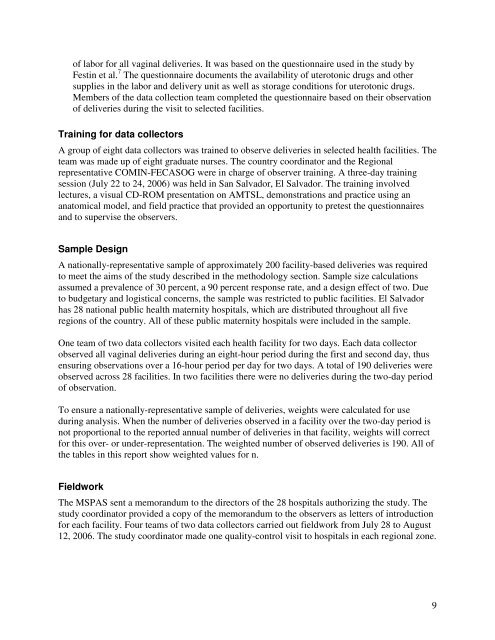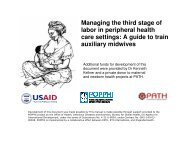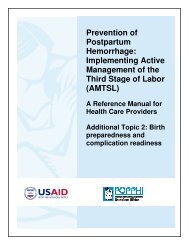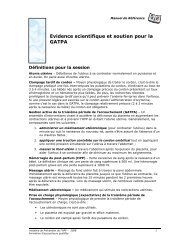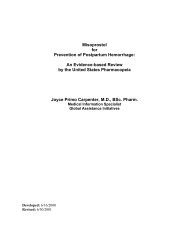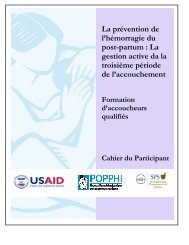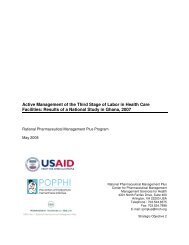2. MethodsThis study is part <strong>of</strong> a multiple country study to assess use <strong>of</strong> AMTSL among facility-baseddeliveries. The development <strong>of</strong> <strong>the</strong> study was a participatory process which involved an initialexpert meeting in Washington, DC in May 2005 to elicit feedback on <strong>the</strong> draft protocol, aplanning workshop in Nairobi, Kenya in July 2005 for <strong>the</strong> first two country studies, and planningworkshops in Panama and <strong>El</strong> <strong>Salvador</strong> in January and February 2006 with representatives <strong>of</strong> <strong>the</strong>Central American Federation <strong>of</strong> <strong>the</strong> Associations and Societies <strong>of</strong> Gynecologists andObstetricians (COMIN-FECASOG) to fur<strong>the</strong>r refine <strong>the</strong> protocol and questionnaires before <strong>the</strong>beginning <strong>of</strong> data collection in <strong>El</strong> <strong>Salvador</strong>, Guatemala, Honduras, and Nicaragua.In <strong>the</strong> case <strong>of</strong> <strong>El</strong> <strong>Salvador</strong>, prior to data collection <strong>the</strong> study protocol was submitted to andapproved by <strong>the</strong> Ministry <strong>of</strong> Public Health and Social Work (MSPAS) <strong>of</strong> <strong>El</strong> <strong>Salvador</strong>. Followingthis approval, <strong>the</strong> protocol was submitted to <strong>the</strong> Committee for Human Research at <strong>the</strong> JohnsHopkins Bloomberg School <strong>of</strong> Public Health in Baltimore, Maryland. The Johns HopkinsCommittee for Human Research judged <strong>the</strong> protocol to be exempt from review for humansubjects research because no personal identifiers were collected and because <strong>the</strong> proceduresobserved were all standards <strong>of</strong> care. They did specify that informed consent must be obtained atadmission to <strong>the</strong> health facility and not in <strong>the</strong> labor and delivery room. In this study, informedconsent consisted <strong>of</strong> describing <strong>the</strong> study and requesting participation from women at admissionto <strong>the</strong> health facility. PATH deferred to Johns Hopkins for <strong>the</strong>ir review. The MSPAS did notconsider review by local ethics committees to be necessary.Questionnaire developmentThe processes and outcomes identified in <strong>the</strong> conceptual framework for <strong>the</strong> study (Figure 1.1)determined <strong>the</strong> content and number <strong>of</strong> questionnaires required for <strong>the</strong> study. In all, threequestionnaires were developed:• National-level questionnaire. This questionnaire was designed to capture <strong>the</strong> policyenvironment for AMTSL. It includes questions regarding <strong>the</strong> content <strong>of</strong> <strong>the</strong> essential druglist, STGs, pre-service training curricula, procurement practices for uterotonic drugs, andstorage conditions for uterotonic drugs at <strong>the</strong> central pharmaceutical storage site. Completingthis questionnaire required document review, interviews with MOH staff and o<strong>the</strong>rpolicymakers, and a visit to <strong>the</strong> pharmaceutical storage site. The study’s country coordinatorconducted <strong>the</strong> national-level data collection.• Facility-level questionnaire. This questionnaire was designed to capture <strong>the</strong> policyenvironment at <strong>the</strong> individual facility level. It includes questions on <strong>the</strong> availability <strong>of</strong>clinical guidelines in <strong>the</strong> facility, provision <strong>of</strong> in-service training on AMTSL, <strong>the</strong> cost <strong>of</strong>uterotonic drugs to <strong>the</strong> facility and to patients, access to <strong>the</strong> facility pharmacy, procurementpractices for uterotonic drugs, and supply and storage conditions at <strong>the</strong> facility. Completingthis questionnaire required interviews with hospital administrators and <strong>the</strong> pharmacist and avisit to <strong>the</strong> facility pharmacy. One <strong>of</strong> <strong>the</strong> two members <strong>of</strong> <strong>the</strong> data-collection team completedthis questionnaire during his/her visit to selected facilities.• Observation-<strong>of</strong>-deliveries questionnaire. This questionnaire was designed to documentprovider practices during <strong>the</strong> third stage <strong>of</strong> labor and <strong>the</strong> first 30 minutes <strong>of</strong> <strong>the</strong> fourth stage8
<strong>of</strong> labor for all vaginal deliveries. It was based on <strong>the</strong> questionnaire used in <strong>the</strong> study byFestin et al. 7 The questionnaire documents <strong>the</strong> availability <strong>of</strong> uterotonic drugs and o<strong>the</strong>rsupplies in <strong>the</strong> labor and delivery unit as well as storage conditions for uterotonic drugs.Members <strong>of</strong> <strong>the</strong> data collection team completed <strong>the</strong> questionnaire based on <strong>the</strong>ir observation<strong>of</strong> deliveries during <strong>the</strong> visit to selected facilities.Training for data collectorsA group <strong>of</strong> eight data collectors was trained to observe deliveries in selected health facilities. Theteam was made up <strong>of</strong> eight graduate nurses. The country coordinator and <strong>the</strong> Regionalrepresentative COMIN-FECASOG were in charge <strong>of</strong> observer training. A three-day trainingsession (July 22 to 24, 2006) was held in San <strong>Salvador</strong>, <strong>El</strong> <strong>Salvador</strong>. The training involvedlectures, a visual CD-ROM presentation on AMTSL, demonstrations and practice using ananatomical model, and field practice that provided an opportunity to pretest <strong>the</strong> questionnairesand to supervise <strong>the</strong> observers.Sample DesignA nationally-representative sample <strong>of</strong> approximately 200 facility-based deliveries was requiredto meet <strong>the</strong> aims <strong>of</strong> <strong>the</strong> study described in <strong>the</strong> methodology section. Sample size calculationsassumed a prevalence <strong>of</strong> 30 percent, a 90 percent response rate, and a design effect <strong>of</strong> two. Dueto budgetary and logistical concerns, <strong>the</strong> sample was restricted to public facilities. <strong>El</strong> <strong>Salvador</strong>has 28 national public health maternity hospitals, which are distributed throughout all fiveregions <strong>of</strong> <strong>the</strong> country. All <strong>of</strong> <strong>the</strong>se public maternity hospitals were included in <strong>the</strong> sample.One team <strong>of</strong> two data collectors visited each health facility for two days. Each data collectorobserved all vaginal deliveries during an eight-hour period during <strong>the</strong> first and second day, thusensuring observations over a 16-hour period per day for two days. A total <strong>of</strong> 190 deliveries wereobserved across 28 facilities. In two facilities <strong>the</strong>re were no deliveries during <strong>the</strong> two-day period<strong>of</strong> observation.To ensure a nationally-representative sample <strong>of</strong> deliveries, weights were calculated for useduring analysis. When <strong>the</strong> number <strong>of</strong> deliveries observed in a facility over <strong>the</strong> two-day period isnot proportional to <strong>the</strong> reported annual number <strong>of</strong> deliveries in that facility, weights will correctfor this over- or under-representation. The weighted number <strong>of</strong> observed deliveries is 190. All <strong>of</strong><strong>the</strong> tables in this report show weighted values for n.FieldworkThe MSPAS sent a memorandum to <strong>the</strong> directors <strong>of</strong> <strong>the</strong> 28 hospitals authorizing <strong>the</strong> study. Thestudy coordinator provided a copy <strong>of</strong> <strong>the</strong> memorandum to <strong>the</strong> observers as letters <strong>of</strong> introductionfor each facility. Four teams <strong>of</strong> two data collectors carried out fieldwork from July 28 to August12, 2006. The study coordinator made one quality-control visit to hospitals in each regional zone.9


